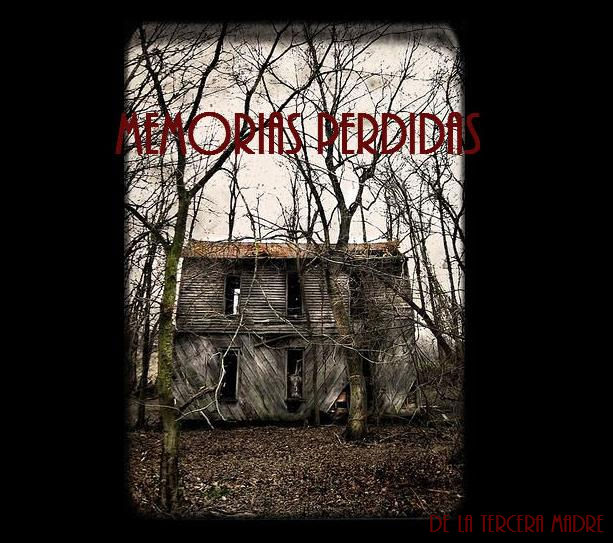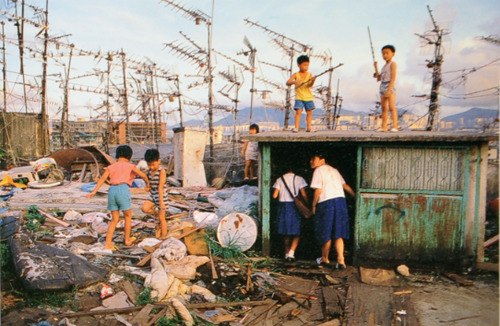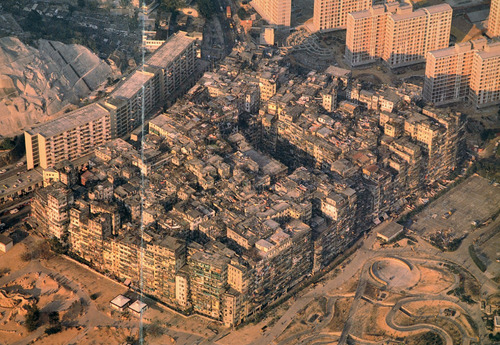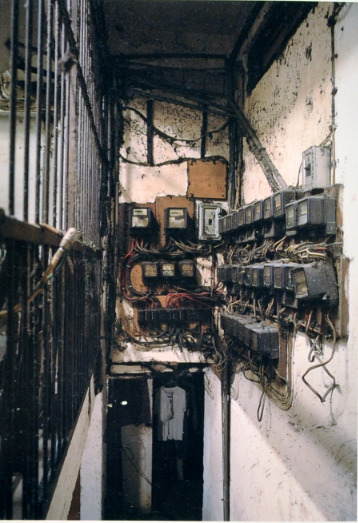 |
| children playing on the roof |
The towers were so high and so closely packed that natural sunlight never reached the lower levels at all, the only light was fluorescent twenty-four hours a day. One could travel one end of the city to the other through a series of ladders, ramshackle bridges and alleyways.
| Aerial view of the city in 1989 |
The City in its final form went back barely 20 years. In origin, however, Kowloon City was much the oldest part of Hong Kong, and one of the few areas in the vicinity populated when the British first arrived in 1841 to claim Hong Kong Island and the southern-most tip of the Kowloon Peninsula for their own.
It was a proper Chinese town, laid out with painstaking attention to eternal principles. The Chinese believed that a town should face south and overlook water with hills and mountains protecting its rear, and in these terms the City was very happily placed, with the great Lion Rock just to the north of it and Kowloon Bay immediately to the south.
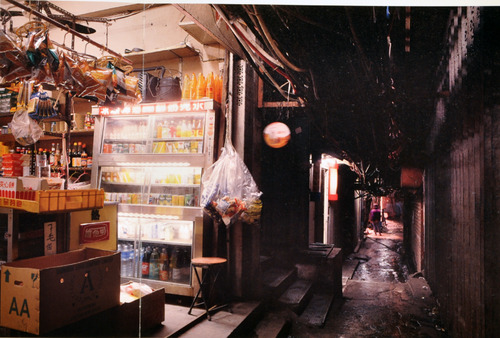 |
| A grocery store inside the Walled City. |
What the geomantic sages could not control were the infringements of the barbarians. When the British sought to expand their hold on Hong Kong in 1898, with a 99-year lease covering the whole of Kowloon Peninsula and all the nearby islands, most of Kowloon City was subsumed under the new jurisdiction.
Under the terms of the lease, however, it was agreed that the small, walled magistrates? fort to the north of the town would remain Chinese territory until the new colonial administration had been properly established and all the details of land ownership, held within the fort, had been transferred.
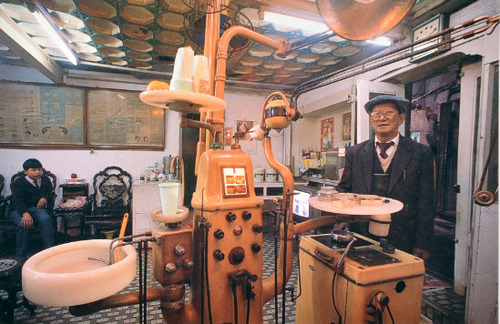 |
| A Kowloon Walled City dentist. |
The situation was never resolved, and for the next 90 years of British rule the City remained an anomaly: within British domain, yet outside British control. The Chinese officials left for good in 1899, but whenever the colonial authorities tried to impose their will, the remaining residents threatened to turn the attempt into a diplomatic incident.
And so it remained until the Second World War, when the invading Japanese delivered the first body blow, tearing down the huge granite walls and using them to build Kai Tak Airport in the shallows of nearby Kowloon Bay. The former harmony was destroyed: the creation of the airport drove away the Yin spirit provided by the water and the City was abandoned.
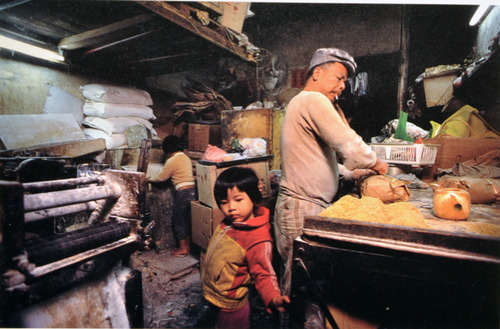 |
| Noodle factory |
The City may have effectively ceased to exist, but the area?s status as a diplomatic black hole was not forgotten, and in the chaos of the War's aftermath it proved the perfect place of asylum for many of the hundred thousands of refugees pouring south to escape famine, civil war and political persecution as the Communists gained control in China.
Surrounded now only by walls of political inhibition, the City became the place where they could get their breath back; where they could live as Chinese among other Chinese, untaxed, uncounted and untormented by governments of any kind.
Surrounded now only by walls of political inhibition, the City became the place where they could get their breath back; where they could live as Chinese among other Chinese, untaxed, uncounted and untormented by governments of any kind.
And so, the Walled City became that rarest of things, a working model of an anarchist society. Inevitably, it bred all the vices. Crime flourished and the Triads made the place their stronghold, operating brothels and opium 'divans' and gambling dens.
Undoubtedly, these few (and it always was a small proportion) kept the majority of residents in a state of fear and subjection, which is why for many years outsiders trying to penetrate were given the coldest of shoulders.
But for most, the main priority was survival and the peoples needs were no different from anyone elses: a life without interference with water, light, food and space. Of these water was the most indispensable and in the early years the only way to get it was to go down.
And so thats what they did, sinking some 70 wells in and around the City, to a depth of some 300 feet. Electric pumps shot the water up to tanks on the rooftops from where it descended via an ad hoc forest of narrow pipes and connections to the homes of subscribers. Only in the last 20 years were Government stand-pipes installed around the City to provide safe drinking water.
Undoubtedly, these few (and it always was a small proportion) kept the majority of residents in a state of fear and subjection, which is why for many years outsiders trying to penetrate were given the coldest of shoulders.
But for most, the main priority was survival and the peoples needs were no different from anyone elses: a life without interference with water, light, food and space. Of these water was the most indispensable and in the early years the only way to get it was to go down.
And so thats what they did, sinking some 70 wells in and around the City, to a depth of some 300 feet. Electric pumps shot the water up to tanks on the rooftops from where it descended via an ad hoc forest of narrow pipes and connections to the homes of subscribers. Only in the last 20 years were Government stand-pipes installed around the City to provide safe drinking water.
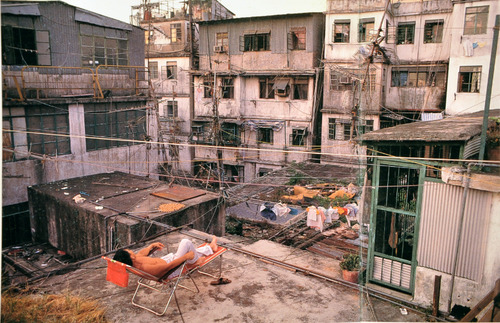 |
| man enjoying fresh air on the roof |
To run the pumps and to light up the Citys many alleys required electricity and initially this challenge was tackled in a similarly robust fashion: it was stolen from the mains, often by Hongkong Electric employees who lived within the City boundaries.
Only in the late 1970s, after a serious fire (much the most terrifying hazard in the City), were the authorities allowed in with their meters.
Thus was the substructure of urban life roughly but workably banged into shape. And out of all the chaos and apparent lack of real organization, a sort of society began to flourish.
Soon, there were factories of every description, small shops and even schools and kindergartens, some of them run by organizations such as the Salvation Army. Medical and dental care were no problem, as many of the residents were doctors and dentists with Chinese qualifications and years of experience, but lacking the expensive licenses required to practice in the rest of the Colony.
Soon, there were factories of every description, small shops and even schools and kindergartens, some of them run by organizations such as the Salvation Army. Medical and dental care were no problem, as many of the residents were doctors and dentists with Chinese qualifications and years of experience, but lacking the expensive licenses required to practice in the rest of the Colony.
They set up their clinics on the edges of the City and charged their patients a fraction of what they would pay elsewhere. Grandparents typically lived with their children and would watch over grandchildren as well as other kids from the area while parents worked.
For the moments of relief from toil, there were many restaurants on the City's fringes and embedded deep in its heart were a temple and a 'yamen', relics of the City's distant past.
And so life went on. Every afternoon the alleys were alive with the throb of hidden machinery and the clacking of mahjong tiles, while up on the roof, in cages not much smaller than some of the City's homes, cooed hundreds of racing pigeons, joined there by children playing after school.
And here, in this richness and diversity, lies what was truly fascinating about the City. For all its physical shortcomings, and there were many, its residents had succeeded in creating a true community - and, ironically, one that was to flourish in the Citys final years, after the authorities had moved in to arrange the clearance and the Triads had been forced to move out.
Photographed by Greg Girard and Ian Lambot during the City's last years, this exhibition offers a glimpse of that unique community and of the extraordinary architecture that had evolved over the years to support it.
And so life went on. Every afternoon the alleys were alive with the throb of hidden machinery and the clacking of mahjong tiles, while up on the roof, in cages not much smaller than some of the City's homes, cooed hundreds of racing pigeons, joined there by children playing after school.
And here, in this richness and diversity, lies what was truly fascinating about the City. For all its physical shortcomings, and there were many, its residents had succeeded in creating a true community - and, ironically, one that was to flourish in the Citys final years, after the authorities had moved in to arrange the clearance and the Triads had been forced to move out.
Photographed by Greg Girard and Ian Lambot during the City's last years, this exhibition offers a glimpse of that unique community and of the extraordinary architecture that had evolved over the years to support it.
 For more information about Kowloon Walled City, look out for Greg and Ianss book, City of Darkness, available from specialist architectural bookshops or via our website at watermarkpublications. com.
For more information about Kowloon Walled City, look out for Greg and Ianss book, City of Darkness, available from specialist architectural bookshops or via our website at watermarkpublications. com.There is also a 1989 German documentary on Kowloon that is worth a look.
